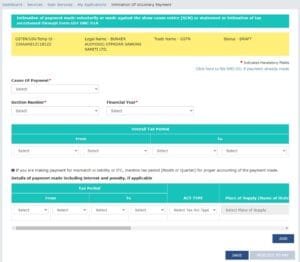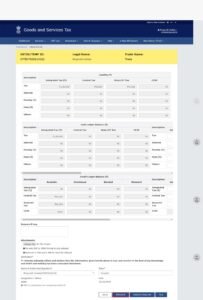Applicability and Procedure to Pay Additional Tax
DRC-03 is a form specified under the Goods and Services Tax (GST) law, used for making voluntary tax payments towards demand or tax shortfalls identified after the time limit for filing returns of a financial year has expired. This form is required to be filed in accordance with CGST Rule 142(2) and (3).
What is form DRC-03?
Form DRC-03 is a voluntary tax payment form under the Goods and Services Tax (GST) system. This form allows a taxpayer to make tax payments voluntarily, either by acknowledging and raising their tax liability or in response to a show-cause notice (SCN) issued by the GST department. It provides taxpayers with a mechanism to rectify any tax shortfalls or discrepancies identified after the regular filing of returns.
When should a taxpayer make payment in DRC-03?
A taxpayer should make payment in Form DRC-03 under the following circumstances:
- Audit/Reconciliation Statement: If during the audit or reconciliation process, the GST auditor identifies any instances of short payment of tax, interest, or penalties, or excessive claim of input tax credit for the audited financial year, and the time limit for reporting these discrepancies in GST returns has expired, the taxpayer must make voluntary payment using Form DRC-03. Additionally, the taxpayer should report these payments in GSTR-9, and the GST auditor should also include them in GSTR-9C.
- Investigation & Others: If the taxpayer is under investigation and it is found that there were incorrect payments of taxes, the taxpayer has the option to voluntarily make payments using Form DRC-03.
- Annual Return: Before filing annual returns, taxpayers are required to reconcile their financial records for the entire year. During this reconciliation process, if any discrepancies are discovered, such as instances of short payment of taxes, interest, or penalties due to non-reporting or under-reporting of taxable supplies, taxpayers can choose to make payments using Form DRC-03. This allows them to rectify any tax differences by paying the outstanding amounts in cash and reporting them accordingly.
- Demand or in response to show cause notice: Form DRC-03 allows taxpayers to make voluntary payments of outstanding liabilities under Sections 73 and 74 of the Central Goods and Services Tax (CGST) Act. Taxpayers have the option to self-assess and voluntarily pay any tax liabilities before the issuance of a show-cause notice (SCN) or within 30 days of the determination of the SCN to avoid the complications of demand and recovery provisions.
Under Section 73 of the CGST Act, cases involve non-payment or under-payment of tax without any intention or invocation of fraud.
Under Section 74 of the CGST Act, cases involve non-payment or under-payment of tax with intention or invocation of fraud.
Taxpayers can use Form DRC-03 to pay the tax demanded along with interest in response to a show-cause notice. However, this payment must be made within 30 days of the date mentioned in the show-cause notice. This voluntary payment option provides taxpayers with a mechanism to address their tax liabilities proactively and avoid potential legal consequences.
- Liability Mismatch – GSTR-1 to GSTR-3B: This option was introduced on the GST portal in February 2021 to provide taxpayers with a reason selection feature when using Form DRC-03. If the tax authorities have issued a notice regarding discrepancies, such as a shortfall of tax liability in GSTR-3B when compared to GSTR-1, the taxpayer is required to either make the payment using Form DRC-03 or respond by providing justifications for the differences. This option provides taxpayers with a mechanism to address and rectify any discrepancies identified between their GSTR-1 and GSTR-3B filings.
- ITC Mismatch – GSTR-2A/2B to GSTR-3B: This option was also introduced on the GST portal in February 2021 for selecting the reason when making tax payments through Form DRC-03. In cases where there are excess Input Tax Credit (ITC) claims in GSTR-3B compared to GSTR-2B, exceeding the limit prescribed under CGST Rule 36(4) of 5% of ITC, tax authorities may issue notices. Taxpayers are required to use Form DRC-03 to deposit the excess claims of ITC identified in their filings. This option facilitates the correction of ITC mismatches and ensures compliance with GST regulations.
Before filing Form DRC-03, certain prerequisites need to be met:
- Voluntary Payment: Form DRC-03 is specifically designed for making voluntary payments of tax liabilities. Taxpayers can use this form to voluntarily pay their tax dues either before the issuance of a show-cause notice (SCN) or within 30 days of receiving the SCN, if it has already been issued.
- Awareness of Tax Liability: Taxpayers should be aware of their tax liabilities and any discrepancies in their tax filings before opting for voluntary payment using Form DRC-03. This includes understanding the reasons for any tax shortfalls or excess claims of Input Tax Credit (ITC) in their returns.
- Availability of Funds: Taxpayers should ensure that they have sufficient funds to cover the tax liabilities they intend to pay voluntarily using Form DRC-03. It is essential to have the necessary financial resources to make the payment without delay.
By fulfilling these prerequisites, taxpayers can effectively use Form DRC-03 to voluntarily address their tax obligations and ensure compliance with GST regulations.
How to file DRC-03
Step 1: Login and navigate to User Services
First Login to GST Portal and go to the ‘My Applications’ select the ‘User Services’.
Step 2: Choose either of the three circumstances under which a taxpayer makes payment:
Case 1: A taxpayer has not made any payment and does not have a Payment Reference Number (PRN).
Case 2: A taxpayer has generated a Payment Reference Number (PRN) but it remains unutilized, and the taxpayer comes for payment within 30 minutes of the generation of the PRN.
Case 3: A taxpayer has generated a Payment Reference Number (PRN) but it remains unutilized, and the taxpayer comes for payment after 30 minutes of the generation of the PRN.
Steps to be performed for Case 1:
Step (a): Choose the Application Type as ‘Intimation of Voluntary Payment – DRC-03’ and then click ‘New Application.

Step (b): A taxpayer will get two options whether payment is made voluntary or against SCN:
- Voluntary payment: The payment date will be auto-populated without an option to edit.
- Payment against SCN: A taxpayer has to manually enter the SCN Number and select the issue date which must be within 30 days of making payment.
To view your saved application, navigate to Services > User Services > My Saved Applications option.
Step (c):Choose the Section under which payment is being made, the Financial Year and then select the from date and to date of the overall tax period.


Step (d): Provide details of payment including interest and penalty. A taxpayer can provide additional details by clicking on ‘Add’. Then, click ‘Proceed To Pay’.
Step (e): Voluntary payment page will be displayed which will be divided into 3 sections:
(1) Liability Details: Liabilities are displayed in this table.
(2) Cash Ledger balance: The cash balance available on a particular date is reflected in this table. The taxpayer has to enter the value of cash to be paid from the available balance against outstanding liabilities.
(3) Credit Ledger balance: Input Tax Credit (ITC) available as on the date is reflected in this table. The taxpayer has to enter the value of the liability to be paid through ITC and click Set-Off.
Step (f): A confirmation message will pop up stating the cash and ITC balance being used up for making payment. On clicking ‘Ok’, a Payment Reference Number (PRN) will be generated along with a successful payment message.
Note: If the Payment Reference Number (PRN) is not available, it can be extracted from the ‘Electronic Liability Register’ under Services > Ledgers > Electronic Liability Register.
Step (g): To view the draft DRC-03, Click the ‘Preview’ button on the page-‘Intimation of payment made voluntarily or against SCN’.
Step (h): Provide reasons, if any, in the field provided. Choose a file in the attachments section to upload. Click on the verification checkbox and then select the ‘Authorised Signatory’ and enter the ‘Place’.
Step (i): Click on ‘File’. Two options will be available:
- File with DSC: Browse the certificate and click on the button ‘sign’.
- File with EVC: An OTP will be sent to the registered mobile number and email ID. On validation of OTP, a success message will be received along with ARN.
Steps to be performed for Case 2
Step (a) Follow the steps as mentioned in case 1 till the taxpayer reaches on Intimation of payment made voluntarily or against the SCN page.
Step (b) Select ‘Yes’ for the option – Have you made payment? and enter the PRN.
Step (c) A link, known as ‘Get payment details’ will be displayed. Once the taxpayer clicks on it, details will be auto-populated on the basis of the respective payment that was made.
Step (d) Click on ‘Preview’ to view draft DRC-03 and then follow the same steps to file the application as mentioned in Case 1.

Steps to be performed for Case 3:
Step (a): Follow the steps as mentioned in Case 1 until the taxpayer reaches the ‘Intimation of payment made voluntarily or against the SCN’ page.
Step (b): Select ‘Yes’ for the option – Have you made payment? and enter the Payment Reference Number (PRN).
Step (c): A link, known as ‘Get payment details’ will be displayed. Click on the link and enter the details manually, as the details will not be auto-populated due to the 30-minute time limit having passed.
Note: The system will process the information in the backend to verify if the amount entered by the taxpayer matches the payment made. If yes, the intimation form will be accepted. If not, an error message will pop up.
Step (d): Hereafter, follow the same steps as mentioned in Case 1 for filing the application DRC-03.
Note: If the PRN is already utilised, an error message will be displayed asking the taxpayer to enter the unutilized PRN.
After filing Form DRC-03, the following actions occur:
- Status Update: The status of the filing will change to “Pending for approval by Tax officer”. This indicates that the filing has been submitted and is awaiting approval from the tax officer.
- Acknowledgement: The taxpayer receives an acknowledgement in the form GST DRC-04 (Acknowledgement of Acceptance of voluntary payment). This acknowledges the submission of the voluntary payment and serves as confirmation that the tax officer has received the filing.
- No Restriction on Further Payments: There is no restriction on the taxpayer making another payment on a voluntary basis while the acknowledgement by the tax officer is still pending. This allows taxpayers to continue making voluntary payments as needed, even if previous filings are awaiting approval.
For More Information :https://taxgyany.com/

